Recreating (and Wearing) a Pair of 18thc Pattens
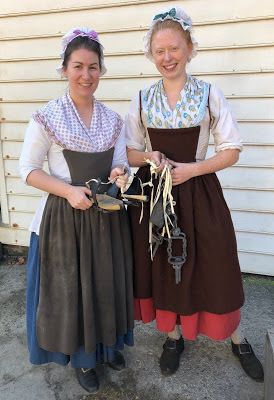 Susan reporting,
Susan reporting,Writing about the past is an ever-changing (and ever-exciting) challenge, and research is one of my absolute favorite parts of the process. I'm always eager to read or hear of new discoveries or fresh perspectives on old ideas, and I never know what may inspire a new character or plot twist.
All of which has brought me back to pattens, a kind of 18thc under-shoe raised up on a metal ring. I've already written a post about them here on the blog.
But while on a recent visit with some of my friends in the Historic Trades program in Colonial Williamsburg , I've come to realize that the subject of pattens is much more complicated.
Fragments of c1770s pattens with a wave-like base, or ring, were discovered in several archaeological digs in Williamsburg, Virginia, and inspired a project at Colonial Williamsburg to recreate them. While pattens would have been the specialized work of a professional patten-maker in 18thc England, in 21stc Colonial Williamsburg they required the skills of several different tradespeople.
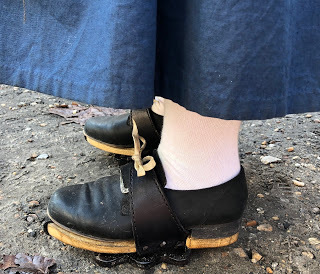
Aislinn Lewis, journeywoman blacksmith, made the wavy rings and hardware that held the ring and straps to the sole, and completed the final assembly. Jay Howlett, journeyman artificer and leatherworker, made the leather straps and leather laces. Paul Zelesnikar, journeyman wheelwright, carved the wooden soles from ash. Jenny Lynn, apprentice tinsmith, has worn the finished pattens as part of CW programming. All of them contributed historical research and construction suggestions.
While the fragments were clearly worn in colonial Virginia, no documentation has yet been found to prove that pattens were being made or even sold in the colony at that time. It's probable that the pattens were imported from England, and possibly considered such mundane objects that they weren't listed for sale in newspaper advertisements.
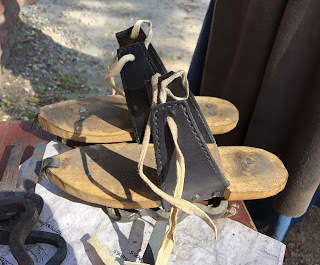
The replica pattens are based not only on the fragments, but also on other, more complete examples that survive in other museum collections. Pattens were inexpensive, workaday footwear that likely didn't have a long life. The flat wooden soles were carved to fit beneath the wearer's shoes, and were held in place by a leather strap that tied across the instep. The metal ring raised the wearer about an inch above the muck of 18thc life, protecting her shoes.
But as Jenny Lynn actually wore the pattens, she discovered a number of things that scholars hadn't realized. First of all, walking in pattens is an acquired skill. Jenny likens it to walking in high-heeled mules. Because there's no back-strap, the wearer's weight must push forward onto the ball of the foot, or she'll walk right out of the soles. An 18thc woman who wore pattens regularly would have been familiar with how best to walk in them, but a certain amount of shuffling must have been unavoidable.
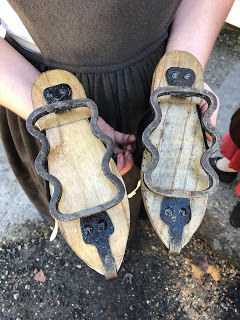
While the assumption has always been that pattens were worn on the notoriously unclean 18thc city streets, Jenny found that this kind of patten would be almost impossible to wear on cobblestone streets, where the rings would slip and tip and lead to sprained ankles and falls. They seem much better suited to the softer surfaces of a more rural life, like an unpaved path or street. Jenny found they work particularly well in mud or wet grass, though if worn by a wealthier woman than a lowly apprentice (sorry, Jenny), the pattens also probably served for making a short journey from a house to a waiting carriage.
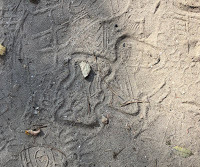
The photos here show Jenny (in the blue petticoat) and Aislinn (in the red petticoat) holding the various components to the pattens, as well as close-ups of the soles and rings, and the pattens both on and off the foot. Perhaps my favorite photo is lower right, with the distinctive marks left by the patten-rings mingling with the modern sneaker-treads of CW visitors. The video, below, shows Jenny walking in them.
Many thanks to Jenny Lynn and Aislinn Lewis for their assistance with this post!
All photographs ©2018 by Susan Holloway Scott.
Published on October 14, 2018 17:48
No comments have been added yet.



